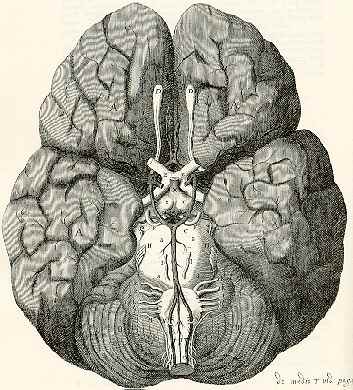

Renato M.E. Sabbatini, PhD

English physician, anatomist and physiologist (1621-1675). He was the Sedleian Professor of Natural Philosophy at Oxford, England, 1660-75.
 Willis studied the anatomy of the central nervous system
and the circulation of the blood (Cerebri
Anatome, 1664, a book with remarkable
drawings by the great architect Sir Christopher Wren). He described what was later known as the "circle of
Willis", a vascular complex at the base of the brain, and described its function. Willis was the first natural
philosopher to use the term "reflex action" to describe elemental acts of the nervous system. He also
wrote Pathologiae Cerebri et Nervosi
Generis Specimen, 1667 (An Essay
of the Pathology of the Brain and Nervous Stock) and of De
Anima Brutorum, 1672 (Discourses
Concerning the Souls of Brutes).
Willis studied the anatomy of the central nervous system
and the circulation of the blood (Cerebri
Anatome, 1664, a book with remarkable
drawings by the great architect Sir Christopher Wren). He described what was later known as the "circle of
Willis", a vascular complex at the base of the brain, and described its function. Willis was the first natural
philosopher to use the term "reflex action" to describe elemental acts of the nervous system. He also
wrote Pathologiae Cerebri et Nervosi
Generis Specimen, 1667 (An Essay
of the Pathology of the Brain and Nervous Stock) and of De
Anima Brutorum, 1672 (Discourses
Concerning the Souls of Brutes).
Willis attempted to correlate the knowledge of anatomy, physiology, and biochemistry with clinical findings in neuropathology. He was a member of the "iatrochemistry school", which believed that chemistry was the basis of human function, rather than mechanics, as was the main belief of that time.
In relation to the search for the brain correlates of the mind, Willis extended the concepts proposed by the Roman physician Galen, that the brain was the organ responsible for the excretion of animal spirits (which was tought to originate from the cribiform plate, a bone in the base of the skull, overlying the nasal cavity). Willis proposed that the choroid plexus was responsible for the absorption of cerebrospinal fluid. Later, in De Anima Brutorum, he proposed that the corpus striatum received all sensory information, while the corpus callosum was associated with imagination and the cerebral cortex with memory.
Internet Resources
Renato M.E. Sabbatini, PhD
Brain & Mind Magazine
Copyright (c) 1998 The State University of
Campinas, Brazil
Center for Biomedical Informatics